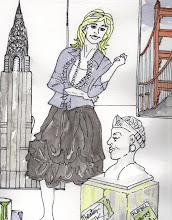Carless in Seattle, I took the lite rail downtown and then hopped on the monorail to the shopping district. Sauntering along the sidewalk in the sun with just a siren on a cup of java as my companion, I was thinking about an upcoming trip to Sonoma. Outside of the San Francisco Bay Area, I would need a car. I pictured myself crossing the Golden Gate Bridge in a white convertible, blonde hair snapping in the wind, sun glinting off the fake diamonds in my Prada sunglasses. Ah, California! I snapped out of my reverie when I realized I was directly across the street from the office of a car-share rental office. I went in, signed up, and exited with my new card—literally the key to thousands of vehicles I had yet to know. I would soon be zipping my way to NapaSonomaland.
My credit card and insurance approval happened right away but, three days later, the car-share system still wasn’t recognizing me. I called customer service and left a message. I thought since I couldn’t talk to a real person—this was probably wasted effort. But the next day—at the airport boarding gate—I received a voice mail message on my cell phone saying that the glitch had been fixed and I was declared “ready to rent.” So, there I was, moments before departure, making my car-share rental reservation. I checked my email while waiting for my luggage, and discovered that I’d been assigned a car in the area I’d calculated would be most convenient to BART—and would be well-populated with tourists at the time of night I was arriving.
I grew up in the San Francisco Bay Area. My blood still contains residue from painfully learning to drive in the City’s hilly terroir. But figuring out where I wanted to disembark from BART had been a challenge. My flight would arrive in evening: That meant riding BART after dark, in a big city, during a recession. I would have my adored Cole Haan handbag (the one that reeled in admiring comments from women who love fashion) over my shoulder and be pulling a suitcase and a Tumi computer bag. Any one of these items could attract unwelcome attention. I didn’t want that sort of excitement to add to my tales of what I did on my summer vacation.
When I made my car rental reservation, I selected Market Street as the pick-up point. A welcoming light shone from a Starbucks store just on the other side of the BART turnstile. I wrestled my bags into a corner of this Italian style (Read: No seats) coffee shop, and ate what was to become my dinner. Several more e-mail messages from the car-share rental dispatchers had blipped their way into my inbox. I derived comfort from knowing that some digital dispatcher somewhere out there was tracking my progress. But the last e-mail message explained that the dispatcher—who was terribly sorry for any inconvenience—had to redirect me to a different car than the one I selected. The problem, it seemed, was that the white convertible was in need of some basic maintenance—wipers and such—so I’d been matched with another car not far from the location of the first. I was going to rendezvous on a street corner in San Francisco with Poet.
My sleek convertible had morphed into a Prius, my flight had been delayed, the sun had set hours ago, and my worried friends in Santa Rosa were calling every half hour to find out what had happened to their house guest. The car-share rental dispatcher was worried about me, too. The reservation time for my rental had passed and they noticed, via radio frequency identification (RFID), that I’d not yet picked up the car.
Fearful that my reservation might be cancelled if I didn’t soon reach the car, I struck out for the teeming streets. Within the first few yards, I encountered an out-of-order elevator. I stood in front of the dark cavity and tried to picture myself tackling the stairs with two rolling suitcases.
A homeless man—sitting on the concrete, his back against the stairway entrance—instantly comprehended my plight. He directed me to a working elevator (he knew his street) and I emerged from the underground where—as though cued by a director to hit his mark at that corner—a taxicab pulled up. I thought of him as my taxi-angel; he arrived just when I needed him, just as my plight was beginning to edge toward absurdity. He was my Ukrainian dancer lifting my luggage in an effortless orchestration of urban efficiency. Igor had lived in the States for 17 years, spoke good English—and happily—he understood my challenge. I was looking for a car I had never seen in the parking lot of an auto repair shop whose location I knew only from the email I had opened just moments before in Starbucks. Oh, and I had never rented a car-share before and wasn’t at all sure how to get into the car.
Igor assured me that he never abandoned the ladies, and that I need not pay him extra to stand guard while I tried out my untested key card. Then there was the small matter of starting the car. Neither Igor nor I had ever driven a hybrid. My solicitous car-share partners had anticipated that, too, and included easy step-by-step instructions in their e-mail for using the keyless entry and making the Prius go. The instructions were perfect. Igor had something new to brag about at the taxi stand, and he took the well-deserved tip.
Deprived of both map and bird's eye view, I really didn’t have any idea where I was. I swiftly struck out with the confidence of the truly ignorant, only to find myself winding my way up Telegraph Hill to Coit Tower. It was a fast trip. As I swung round the no-parking loop, I was able to see that there was nothing to see. San Francisco was wearing her pea-soup cloak.
As I drove toward the dark hills of Petaluma, I thought how lovely it would have been to roll back a sun(moon)roof to see the night sky overhead. But I’m afraid my awe would have been disrupted by a fundamental need to navigate by the stars. I had to place several calls to my waiting friends in order to make the correct turns to get their ranch; it had been many years since I had made this drive. On that trip, I had referred to a detailed map, folded just so; and it was broad daylight. But, here I was, with a well-charged phone that had become my lifeline—first, connecting me to the arrangements and exigencies of the car-share guardians, and then to my friends, who were keeping the light on for me.
As Poet and I cruised along the winding roads on the gum-drop hills of our wine country adventure, I could feel myself turning greener. I also became aware that Poet, whether he liked it or not, was a pick-up car. Men would spot the car-share logo and go out of their way to ask me how I liked the rental service and what I thought of the Prius. Those men accompanied by wives just cast my way the sort of look women give to someone walking a sweet, cuddly puppy. They kept their hands in their pockets, but their faces softened and their eyes brightened at the sight of that sweet little car. To be honest, I never disclosed to these California conservationists that I happened to be driving the environmentally friendly hybrid because the wipers were worn out on my first choice: A hot, 6-cylinder manly chariot of a convertible, that I know blared Beach Boy tunes in all the intervals where Poet chose to be his quiet, erudite self.
Poet and I became close. There was something particularly intimate about the long silences when Poet was in his electric mode. We were so in tune, that I suspect I was subconsciously reluctant to end our relationship. No matter that I hate long goodbyes. I drove around San Francisco for about two hours during evening commute before I was able to relocate the exact spot at which I had picked up my Poet, four days earlier in a dark fog reminiscent of London’s East End. I learned that you can’t ever make a left hand turn on 19th Street while heading west, that it is difficult to find a gas station at which one can buy a map in San Francisco, that you need to seriously consider if it is safe to get out of the car when you do find a gas station, and that drug addicts who hang out near the restrooms (which you have strongly begun to need after a two-hour tour of the city) at gas stations will suggest that they can get you anywhere you need to go; they have connections. It became increasingly clear to me that requesting a GPS in future car-share rentals, particularly in cities that I did not frequent, would be a good thing. As it were, the cost of the map that I did ultimately buy—no doubt risking my health, if not my life, in the process—probably cost about as much as adding a GPS to my car reservation.
As I remember, it seems that I even had trouble finding a place to pull over in San Francisco. This is the only reason I can come up with for not using my option to text my concerned car-share rental dispatcher and ask for an extension. As I negotiated the frenetic traffic that is an essential aspect of the commute-time experience, my devoted dispatcher was sending text alerts that my reservation was nearing an end. I got a bad mark from the car-share company for not returning Poet on time. Apparently, Poet didn’t speak convincingly in my defense. But I don’t hold it against him. It was all part of the experiment to try on a car-share arrangement. And despite our starts and stops, I have fond memories of Poet.

.JPG)








